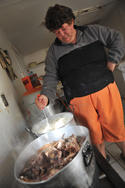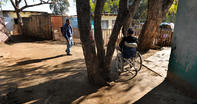Transactions in Various Currencies

The economy of Sonskynhoekie (an informal camp for the impoverished) is a no-frills affair, rudimentary but functional. Transactions are in various currencies – sometimes lower cash denominations, sometimes in kind – and an argument could break out over an unpaid debt of just R3.
Some of the residents work at a nearby clothing factory or at the owner’s (the Duvenhages’) scrapyard on the property. Some live off pension or disability grants. Others – like Allison or Oom Mike (a mottled alcoholic with a humanities degree of some sort) – exchange their labour for board and lodging.
Allison has her gig in the kitchen, Mike is the security on the gate during the day. Others patrol at night to keep the tsotsis (criminals) away, for R30 or so a shift. Then there are those who work the traffic lights. Kobus van der Westhuizen is a docile fellow with a greying Magnum PI snor (moustache) and a missing top third of his left forefinger.
Although the camp matriarch, Cornelia, is still legally married to someone else (she cannot be bothered with the hassle of the divorce paperwork, and they have been separated for nearly ten years now), she calls Kobus ‘haar man’ (her husband). He was here when she arrived, a man widowed when a minibus taxi hit his wife when he was in the army. He lost himself in alcohol, and in the process his scrap metal business and pretty much everything else.
Ablutions at the Camp
The ablutions at Sonskynhoekie are about as crude as the camp’s economy, little more than a square block tagged onto the side of Annetjie’s (the owner’s daughter-in-law’s) house: the tatty his and her bathrooms; an adjacent room for cooking. Inside the women’s: two doorless toilet cubicles; a disused shower; a basin whose taps are no longer tethered to the pipes which once fed them water.
The men’s: two loos; the urinal and basins long gone, ripped from the walls; a disused shower. Other than this – two toilets per bathroom to relieve oneself, and running water to flush – it is everyone for themselves, you bring your own toilet paper. Brown streaks like finger paintings on the walls suggest an alternative for those who have run out of toilet paper.
On the other side of the camp is a newer two-shower block with a ‘donkey’ (a rudimentary water boiler using an open wood-fuelled fire to heat a cylinder) simmering away out the back. The donkey’s fire is permanently stoked, with the entire length of a felled gumtree constantly being fed into its smouldering embers. A bricks-and-mortar home with a bath, that is one of Cornelia’s dreams.
In the meantime, she scouts the local flea market for plastic tubs big enough to bath in inside her Wendy, and tries to rig up running water from the JoJo tank outside Annetjie’s house. She has already got the donkey set up, which she will use to heat the water once she gets the right pipe connections. Until then, though, her Wendy is dry.
Home for Cornelia and Kobus

The corrugated tin walls of the shack are lined with curtains to insulate against the heat of summer and the bitter chill of winter.
A shelf above the bed, and the bookshelf, are lined several rows deep with soft toys: pink-footed rabbits; sky-blue teddies; a knitted elephant in blue trousers; a glossy black nose beneath a Paddington Bear hat; a star-shaped cushion bleached to a pale pink by the sun; Elmo, from Sesame Street, mouth gaping in a state of rigors. It is a cacophony of synthetic, furry, pastel limbs, heads, button eyes and bows.
They are her children, Cornelia says, without much conviction, of the toys that arrived here with the donations of clothing parcels. The children take them, play with them, abandon them. So she picks them up and brings them home.
Kobus leaves for work before five every day, usually on just a cup of coffee, and heads into Centurion where he will work the traffic lights with his board, handwritten by Cornelia: ‘Please help me. Need work. Or any donation you can help me.
Thank you. God bless.’ Sometimes he will get a job in someone’s garden, or a quick painting job, which will bring in R150 or so. Otherwise people might give him some change, R2 here or R10 there. ‘Every night he comes home with a few rands.
That’s why I eat my own food. I eat basically on my own.’ He does not take food with him, and she knows if he walks in after Sewende Laan and asks for a bit of bread, then he has not eaten all day. If he does not, ‘dan het hy lekker daar lanks die pad geëet’ (‘then he ate well on the side of the road’).
Livelihood Strategies at Sonskynhoekie
To understand food security at a household level, researchers at the Human Sciences Research Council (HSRC) talk about four key indicators. Firstly, it is about basic volumes: is there enough food in the home? Secondly, the quality: what type and diversity of food does the family or individual have? Third, there is the psychological side of things.
The HSRC’s Professor Demetre Labadarios and others, writing in a 2009 assessment of food insecurity in the country, say that food insecurity is accompanied by ‘feelings of deprivation or restricted choice for individuals, and by anxiety about the amount and types of food at hand in the household stores’.
Fourth and finally, there is the question of whether people are able to access food within their own context in a way that complies with the community’s ‘social norms’: do they eat three meals a day, for instance, or are they able to get hold of food without ‘having to beg, rely on charity, scrounge or steal food’?
In the universe of Sonskynhoekie, two meals a day is standard; accepting charity is the norm; begging is just ‘work’. Cornelia and Kobus’s various ways of making ends meet, in a world that exists outside of formal employment, seems fairly typical of many poorer communities. They have several irons in the fire, each of which gives another layer of resilience in an uncertain world.
In its survey of eleven cities across the SADC region, the African Food Security Urban Network (AFSUN) found poorer communities had a small arsenal of livelihood strategies, which they use to buffer them against external shocks like, for instance, the breadwinner losing a job. The first line of offence is casual labour, something which Kobus trawls for every day when he stands at the traffic lights with his board.
Living Far From the City
Sonskynhoekie’s distance from the city is something that many of the people living here complained about. It is far from ‘work’, many pointed out, by which they might mean it is hard to find casual labour opportunities or even just begging at the traffic lights.
South Africa’s apartheid policies are still stamped on the geography of its cities, where city planners put pools of black and coloured labour on the periphery of the city – close enough to serve business, industry and the suburbs, but far enough not to be a blight on white economic hubs.
It will take decades of geographic transformation and economic growth to deconstruct such a cemented socio-economic landscape. Being stuck out in a township or slum increases the cost of living for poorer people since they are far from all the important hubs they need to access the economic bloodstream: transport hubs and the main lines to employment, sources of food, schools, clinics and hospitals. The further you are from the working parts of the city, the more it costs to get anywhere, cementing a person’s place on the fringe of the city.
By Leonie Joubert